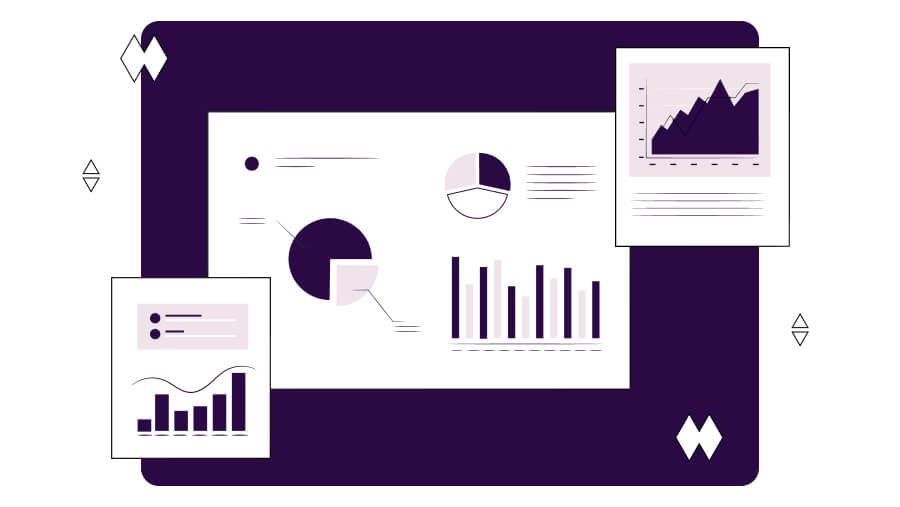
Data-Driven Marketing: A Complete Guide for B2B Marketers
Have you ever wondered what your business is missing out on by not embracing the prowess of B2B data-driven marketing? The answer is unparalleled growth and precision in reaching the right audience.
As per the McKinsey report, businesses that utilize data-driven strategies witness an average 20% increase in sales.
Such a significant boost is possible as data offers you with:
- Real-time insights
- Personalized targeting and measurable ROI
- Enhanced efficiency and relevance in an ever-evolving market landscape
Now, imagine harnessing that power for your success with B2B data-driven marketing!
Let us explore our guide to navigating the world of data-driven marketing. It shares easy steps to transform your B2B approach and other relevant things you must know.
The Need For B2B Data-Driven Marketing
In B2B marketing, you always try to win over those heavyweight decision-makers in your target companies. These aren't your everyday consumers; they're the CEOs, the hot potential clients.
So, you need to understand precisely what they want.
And how do you get that insight?
Through data-driven marketing!
Where 87% of marketers aren't using data as they should, it's your golden chance to adopt this approach and move ahead of them in the market.
Though data is always essential for better lead generation and prospecting in B2B, there are some instances where it's a must.
Let's learn about those instances in brief:
1. Initial Market Penetration and Product Launch
You must use a data-driven approach when you are about to step into a new market or launch a product. It helps in:
- Understanding the target audience
- Identifying market trends
- Fine-tuning strategies based on real-time insights
It ensures a more informed and effective product entry into the market. Hence, you increase the chances of a successful launch.
2. Strategic Expansion and Market Diversification
As your company grows, you want to expand into new markets or diversify your product/service offerings. Your data-driven approach will aid in:
- Assessing market potentials
- Analyzing consumer behavior
- Evaluating potential risks
Plus, you can optimize your resource allocation better and tailor your lead gen strategies for different markets or products.
3. Adaption to Market Changes and Competition
B2B markets can change rapidly, and competition may rise drastically. To stay ahead, you must adapt to changes quickly.
As 40% of B2B marketers are willing to expand their budget for a data-driven approach, you must leverage this marketing method, too.
It lets you monitor real-time:
- Market changes
- Competitor activities
- Customer preferences
This agility helps you make timely adjustments to strategies. Thus, you can stay competitive and ensure your company remains relevant in the ever-evolving market.
B2B Data-Driven Marketing Frameworks
Let us see the best frameworks for effective data-driven marketing:
1. SWOT Analysis
The framework identifies internal and external factors affecting your business. It evaluates your company's competitive position in the market.
The SWOT represents:
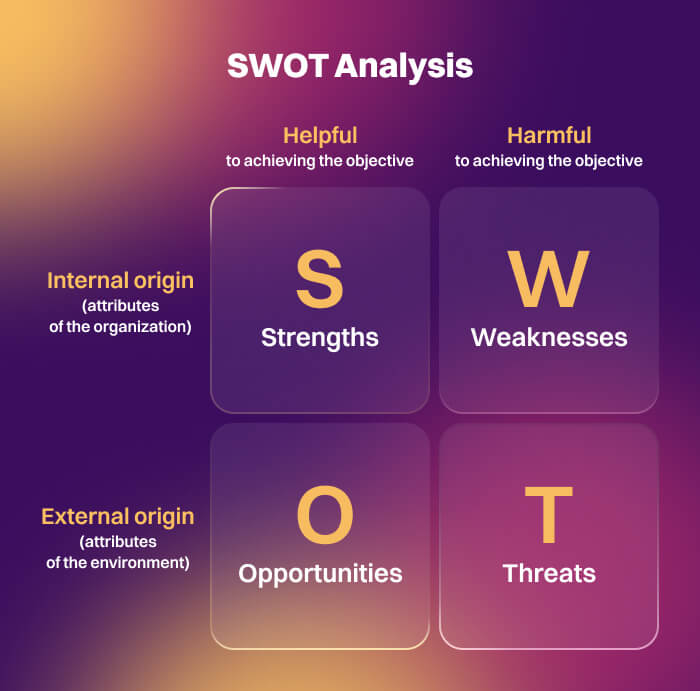
- Strengths- Describe what your business excels at. Plus, its unique value proposition differentiates it from the competition.
- Weaknesses - Pinpoints areas where you need to improve to remain competitive.
- Opportunities- Gathers favorable external factors to give your organization a competitive edge.
- Threats- Outlines factors that can potentially harm your organization.
Conducting a SWOT analysis provides a grounded, fact-oriented, and data-driven assessment of your organization's strengths and weaknesses. Thus, you can use this information to develop strategic planning for pursuing your target audience.
Tip- Make sure your SWOT analysis stays reliable by steering clear of pre-set opinions or unclear areas. Instead, concentrate on real-world situations.
2. HADI Cycle
The HADI cycle provides a pragmatic approach to using your target audience's data. The process involves:
- Formulating and testing ideas
- Gathering data
- Drawing conclusions
- Implementing improvements to optimize results
HADI represents:
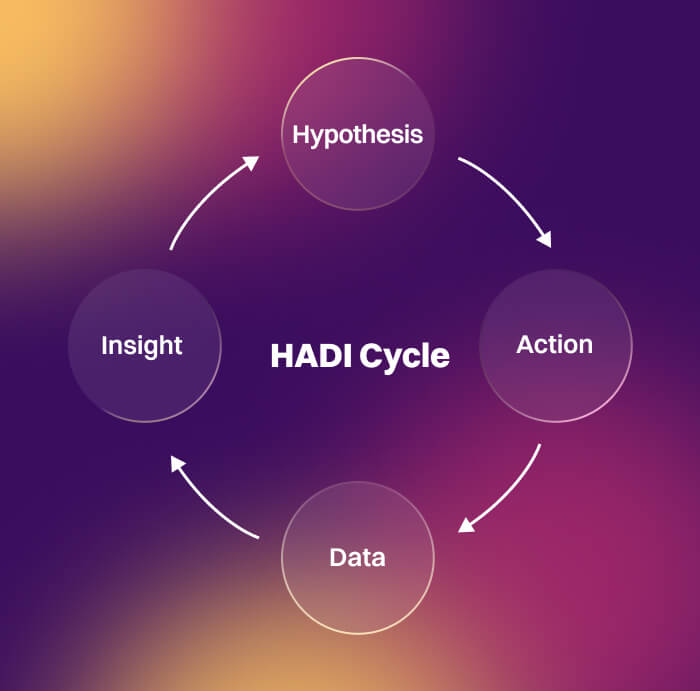
- Hypothesis (H): Formulates educated guesses or hypotheses based on existing knowledge or assumptions. It outlines what you aim to achieve or understand.
- Action (A): Pushes strategic actions or changes based on the formulated hypothesis. Here, you put ideas into practice to observe their impact.
- Data (D): Collects data systematically. This data could be quantitative or qualitative, depending on the nature of the hypothesis.
- Insight (I): Draws insights and conclusions. Here, you analyze the data to understand patterns, correlations, or any meaningful information that can contribute to informed decision-making.
3. Value Proposition Canvas
The framework ensures a product or service aligns with the values and needs of your target customer. It comprises two key elements:
- The customer profile
- The company's value proposition
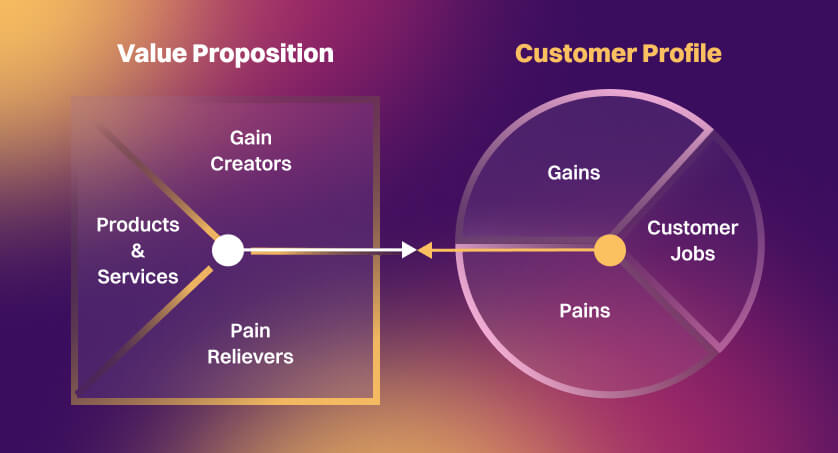
Customer Profile
- Gains: Lists your target customers' anticipated benefits from your offering. Plus, some elements help you decide your value proposition.
- Pains: Includes the adverse experiences, negative emotions, and risks encountered by your target customer while fulfilling a particular business operation.
- Customer Jobs: Includes functional, emotional, and social tasks your target customers aim to solve.
Company's Value Proposition
- Gain Creators: Elucidates how your product or service generates gains for the target customer and adds value to their experience.
- Pain Relievers: Describe precisely how your product or service mitigates the target customer's pains.
- Products and Services: Identifies the specific offerings that create gains and alleviate pains. It forms the foundation for delivering value to the customer.
Once you determine the needed information per the above points, rank each point from 'Good to Have' to 'Essential' on a scale – based on its perceived value to your target customer.
4. Competitive Positioning Matrix
This framework requires you to develop a matrix to compare your positioning strategies with your competitors. You need to compile a roster of brands targeting similar audiences as yours.
Then, meticulously note the strengths and weaknesses of each. Compare this data to assess how your brand performs to others in the market.
You can assess various factors, including:
- Key messaging
- Unique selling points
- Brand representation
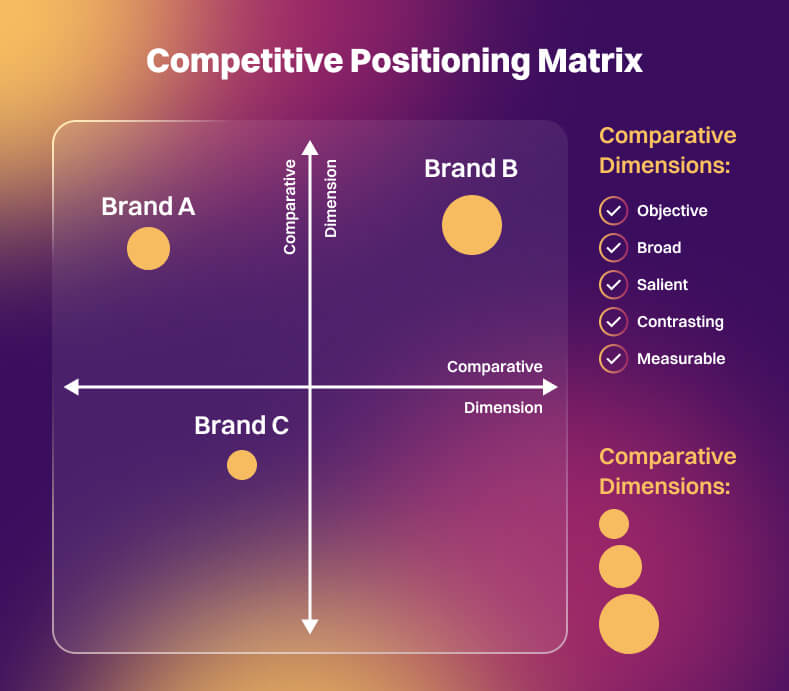
This matrix is a valuable tool to identify white space within your market. Thus, it lets you pinpoint strategic positioning angles that set your business apart from competitors.
Steps To Deploy B2B Data-Driven Marketing
Here are our curated quick yet powerful steps to implement data-oriented marketing in your B2B business:
1. Get Needed Human Resources and Tools in Place
Ensure you have a skilled team who can efficiently leverage data in the marketing strategy. Implement robust analytics tools like Google Analytics, Mixpanel, or other industry-specific tools. They help collect and interpret your target audience's data, enabling you to make informed marketing decisions.
Tip: We recommend you blend data analytics with the intuition and experience of your marketing team for a well-rounded approach.
2. Choose Framework(s) to Implement
You can choose any data-driven marketing framework or a combination of frameworks that complement your marketing strategy.
Our experts recommend the following:
- HADI Cycle for a systematic approach to using your audience's data.
- Combination of HADI with SWOT Analysis to better collect marketing-related data of your target audience.
3. Analyze Current Marketing Strategies
Perform a thorough analysis of current marketing strategies. Understand what's working and what needs improvement. Use data analytics tools to gather quantitative data and leverage your team's expertise for qualitative insights.
4. Identify Your Marketing Effort's Problem Areas
Pinpoint specific challenges or weaknesses in your current marketing efforts. It could be based on:
- Data analysis
- Customer feedback
- Market trends
Further, you can compare your findings with your competitors. It'll help you identify areas where your competitors might outperform you. To do so easily, our experts recommend implementing the Competitive Positioning Matrix framework.
5. Initiate a Data-driven Culture
Foster a data-driven mindset within your marketing team. Here's how you can do it:
- Encourage your team members to use data to make business decisions properly.
- Provide training and resources to help your team become more comfortable with data analysis tools and techniques.
- Emphasize that data is a tool for empowerment, not a replacement for human intuition.
6. Pick KPIs and Metrics
Choose Key Performance Indicators (KPIs) and metrics that align with your business objectives. Use the below-given KPIs to analyze your data-driven marketing performance:
- Conversion rates
- Customer acquisition costs
- Customer lifetime value
The Important Role of Data-Driven Analytics in B2B Marketing
By leveraging data-driven analytics, you can mold your marketing strategy to be the most effective. Let's see how it happens:
1. Improve Personalization and Targeting
Imagine speaking directly to the needs and preferences of your B2B clients. That's what personalization achieves.
So, what's the role of data-driven analytics?
Tailor your content and marketing messages based on your target client's behavior, preferences, and engagement data. This precision enhances your target customers' experience with your business. Plus, it can increase the likelihood of conversion.
2. Leverage Predictive Analytics For Decision-Making
Predicting future trends and customer behavior gives you a competitive edge.
It's like having a crystal ball for your marketing strategy!
Here, data-driven analytics helps by using historical data to forecast future trends. It empowers you to:
- Make strategic decisions in the future
- Anticipate market shifts
- Allocate resources effectively
3. Perform ROI Measurement and Optimization
Be sure that marketing is not just about spending on efforts; it's about smart spending. And you can achieve that by knowing what works and what doesn't in your existing efforts.
You can use data-driven analytics to measure and track the performance of your marketing campaigns and return on investment (ROI). Plus, you can use insights to optimize campaigns in real-time, allocating budget to channels that deliver the best results.
4. Build Long-Term Customer Relationships
In B2B, relationships are everything. So, when you build lasting connections with clients, it ensures repeat business and loyalty.
Analyzing customer data helps you understand their:
- Buying journey
- Obstacles they face
- What they want from you
This knowledge enables you to create personalized nurturing campaigns. It fosters trust and loyalty over the long term.
Challenges and Solutions Related to Data-Driven Marketing
You may face the following challenges while adopting data-driven B2B marketing:
1. Data Privacy and Security Concerns
So, what are the challenges here? Let us see:
- Regulatory Compliance: Adhering to various data protection regulations (e.g., GDPR, CCPA) poses a significant challenge. Non-compliance can result in severe penalties.
- Consumer Trust: Privacy breaches and mishandling of personal information can erode consumer trust.
- Data Breaches: The increasing sophistication of cyber threats poses a risk of data breaches.
Now, let's see how you can get over these challenges:
- Study Regulations and Follow: Study all the points related to user data privacy and other essential guidelines and comply with them.
- Incorporate Data Encryption: Implement robust encryption methods to secure data during transmission and storage.
- Maintain Controlled Data Access: Ensure only authorized personnel have access to sensitive data and implement strict access controls.
- Perform Regular Audits: Conduct regular audits and assessments to identify breach-related vulnerabilities and address them promptly.
2. Data Quality and Integration Issues
Here are some probable challenges you can face:
- Data Silos: Disparate data sources and siloed information hinder the creation of a unified and comprehensive view of customer data.
- Incomplete or Inaccurate Data: Poor data quality can lead to flawed insights and misguided marketing strategies. Incomplete or inaccurate data can skew results and impact decision-making.
- Integration Complexity: Data integration from various sources (offline and online channels) can be complex and resource-intensive.
Here's how you can deal with these challenges effectively:
- Run Data Cleansing: Regularly cleanse and validate data to ensure accuracy and completeness.
- Use Integration Platforms: Invest in robust integration platforms that facilitate the seamless data flow between different systems and sources.
- Apply Standardization: Establish data standardization practices to ensure consistency across all data sources.
3. Resistance to Change and Cultural Shift
Let us see some relevant challenges:
- Organizational Culture: Traditional organizational cultures that resist change can impede the adoption of data-driven marketing strategies.
- Skill Gaps: Lack of data analytics and interpretation skills and expertise can hinder successful implementation.
- Uncertainty and Fear: Overwhelmed employees by the introduction of new technologies and processes often fear job displacement.
Worry not; you can tackle the above challenges in many ways:
- Provide Training and Education: Initiate comprehensive training programs to upskill employees and enhance their understanding of data-driven approaches.
- Change Management: Implement effective change management strategies to:
- Address resistance
- Communicate benefits
- Foster a culture of continuous improvement
- Ensure Leadership Support: Secure support from leadership to drive and champion the cultural shift towards data-driven decision-making. You must show the leadership commitment to foster a culture that embraces change and innovation within your organization.
Conclusion
Embrace the significance of data and watch your business thrive. Our suggested steps provide the blueprint for seamless implementation, ensuring you harness the full potential of data to elevate your strategy. Trust Revnew as your reliable B2B lead gen partner, guiding you toward a future of strategic brilliance and sustained growth. Want to know how we can help? Contact us here.
